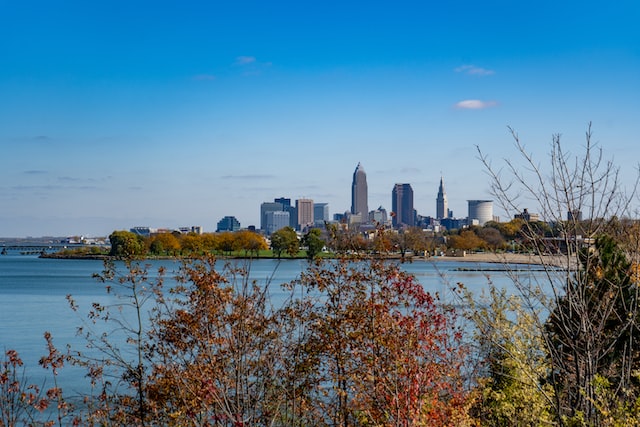The Great Lakes of North America are five large interconnected lakes in USA and Canada. The five lakes are – Lake Superior, Lake Huron, Lake Michigan, Lake Erie, and Lake Ontario. One of the largest freshwater ecosystems on Earth, the Great lakes of North America are glacial lakes that were formed when the melting glaciers filled the depressions with water. Let’s learn about these five great lakes.
The five Great Lakes of North America

Lake Superior
Lake Superior is the largest among the five Great Lakes of North America. It has a surface area of 31,700 square miles (82,100 square kilometers) and an estimated volume of 2,900 cubic miles (12,100 cubic kilometers). The largest freshwater lake in the world by area, lake Superior has a shoreline in Michigan (USA), Minnesota (USA), Wisconsin (USA), and Ontario (Canada).
Lake Superior is also the deepest among the 5 lakes with a maximum depth of about 1,310 ft (about 400 meters).

Key points
- Surface area – 31,700 square miles (82,100 square kilometers)
- Maximum depth – about 1,310 ft (about 400 meters)
- Lake Superior is connected to Lake Huron via the St. Marys River.
- Lake Superior is the second largest lake in the world after the Caspian Sea.
- Large cities along Lake Superior – Duluth (Minnesota), Superior (Wisconsin), Thunder Bay (Ontario)
- Largest island – Isle Royale
(Also read: Top 10 largest lakes in the world by area)
Lake Huron
Lake Huron is the second largest among the five great lakes. It has an area of 23,000 square miles (59,600 square kilometers). Lake Huron is present in Ontario province of Canada and Michigan state of the US.

Key points
- Surface area – 23,000 square miles (59,600 square kilometers)
- Maximum depth – about 750 ft (about 230 meters)
- Lake Huron is connected to Lake Superior via the St. Marys River.
- Lake Huron is connected to Lake Michigan via the Straits of Mackinac.
- The St. Clair River that flows out of Lake Huron flows into Lake St. Clair. Lake St. Clair is then connected to Lake Erie via the Detroit River.
- Largest island – Manitoulin Island
Lake Michigan
Lake Michigan is probably the most famous among the five great lakes. It is located entirely within the borders of the USA in Michigan, Illinois, Indiana, and Wisconsin. Lake Michigan has a surface area of 22,400 square miles (58,015 square kilometers) which makes it the largest lake in the world located entirely within a country.

Key points
- Surface area – 22,400 square miles (58,015 square kilometers)
- Maximum depth – about 920 ft (about 280 meters)
- Large cities along Lake Michigan – Milwaukee (Wisconsin), Chicago (Illinois), Green Bay (Wisconsin)
- Largest island – Beaver Island
Lake Erie
Lake Erie is the second smallest of the five lakes with a surface area of 9,910 square miles (25,670 square kilometers). The US-Canada border passes through the middle of Lake Erie. Lake Erie has a shoreline in Ontario (Canada), Michigan (USA), Ohio (USA), Pennsylvania (USA), and New York (USA).

Key points
- Surface area- 9,910 square miles (25,670 square kilometers)
- Maximum depth – 210 ft (64 m)
- Large cities along Lake Erie – Cleveland (Ohio, USA), Buffalo (New York, USA), Erie (Pennsylvania, USA)
- Largest island – Pelee Island
Lake Ontario
Lake Ontario is the smallest of the five great lakes. It has a surface area of 7,340 square miles (19,010 square kilometers) and is located in Ontario province of Canada and New York state of the US. Just like Lake Erie, the international border between Canada and USA passes through the middle of the lake. Toronto, the largest city in Canada is located along Lake Ontario. The primary outflow of Lake Ontario is the St. Lawrence River which drains into the Atlantic Ocean.

Key points
- Niagara River connects Lake Ontario and Lake Erie. The famous Niagara falls are formed as the Niagara River flows from Lake Erie to Lake Ontario.
- Surface area – 7,340 square miles (19,010 square kilometers)
- Maximum depth – 800 ft (245 meters)
- Large cities along Lake Ontario – Toronto (Ontario, Canada), Mississauga (Ontario, Canada), Rochester (New York), and Hamilton (Ontario, Canada)
Interesting facts
- The Great lakes of North America are also known as Laurentian Great Lakes.
- These five lakes have over 20 percent of the total volume of freshwater on Earth.
- Lake Michigan and Lake Huron are sometimes considered a single body of water as Lake Michigan-Huron.
- The Great lakes of North America are glacial lakes.
Frequently asked questions
Lake Superior (over 1,310 ft/over 400 meters deep)
Lake Superior
Freshwater
Lake Michigan
Lake Superior
Yes